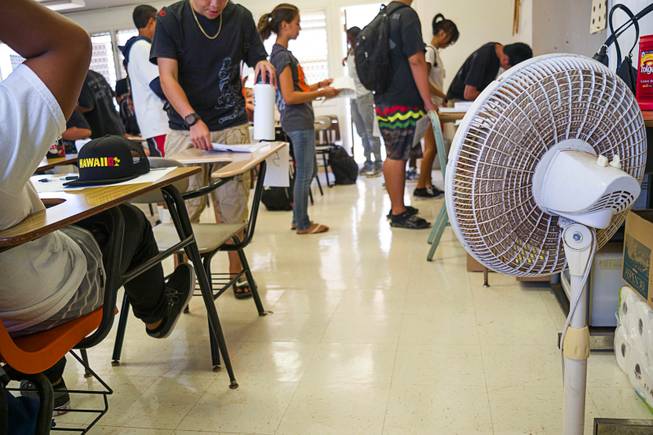
Marco Garcia / AP
In this Aug. 3, 2015 file photo, with only open windows and fans to cool the room down, students enter their non air conditioned classroom at Campbell High School in Ewa, Hawaii.
Wednesday, April 6, 2016 | 1:02 a.m.
HONOLULU — Most of Hawaii's public schools don't have air conditioning, and record-high temperatures have left teachers and students saying they can't focus because of the heat.
Hawaii lawmakers are saying it's time to cool Hawaii's public schools. A proposal passed in the House Committee on Finance Tuesday would fund air conditioning for Hawaii's public schools and speed up the process to install cooling systems in classrooms.
The proposal would also set a goal that all Hawaii's schools are net-zero in energy use by 2035. The bill originally requested $130 million in a loan program and bonds to pay for air conditioning and other equipment to help schools become cooler and more sustainable, but lawmakers blanked out the amount in the most current draft.
The bill says installing air conditioning a single classroom can cost up to $30,000.
Supporters say temperatures in Hawaii's classroom can reach over 100 degrees and that lowering temperatures in hot classrooms is key for student success.
"We all know it was hot this year," said Corey Rosenlee, president of the Hawaii State Teachers Association. "Students and teachers had to go to the emergency room."
The Hawaii Board of Education and Department of Education also spoke in support of the bill, saying it would help the state reach its goal to install air conditioning units 1,000 more classrooms in the next year.
Right now, the state spends about $48 million a year on electricity in Hawaii public schools. If passed, the Department of Education would have to keep energy consumption from climbing more than 10 percent higher, despite putting in more air conditioning units.
The bill says installing energy more efficient lighting, natural ventilation and using renewable technologies such as solar could help cut down electricity costs. Under the proposed law, the state would be required to establish renewable energy projects at a public school in each county to serve as emergency shelters for natural disasters.

Join the Discussion:
Check this out for a full explanation of our conversion to the LiveFyre commenting system and instructions on how to sign up for an account.
Full comments policy